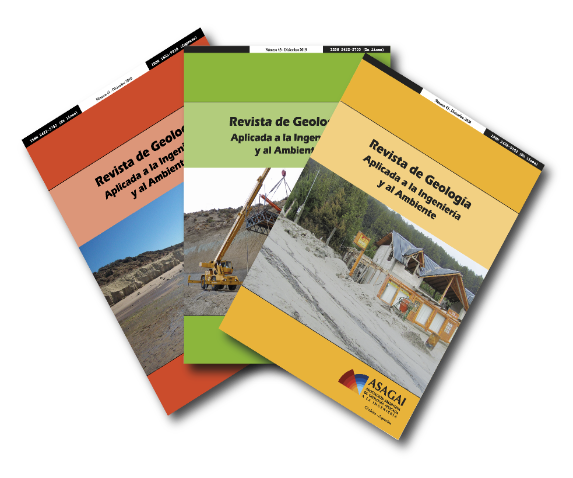Road viaduct in a site of geological - geotechnical complexity
DOI:
https://doi.org/10.59069/24225703e003Keywords:
bearing capacity, foundation, slope stabilizationAbstract
Geotechnical problems in engineering constructions follow paradigms of theory and practice in variable proportions. Geotechnical engineering has the possibility of using standardized research and calculation procedures. However, frequently, the constructions are located in singular places, in which the extrapolation of experiences must be carefully used. Consequently, decision-making in the definition of geotechnical components must solve the problem of the link between the application of conventional calculation methods and the adoption of non-standardized solutions, such as an adaptation to the site of implementation of the work.
The construction of an 800-meter highway viaduct, on the west slope of the Sierras Chicas, in the Province of Córdoba, Argentina, shows this type of situation. The work is located in a mountain area, on the sector corresponding to the formation fault of the hill. The geotechnical study of this sector and the experience in the construction of the work itself, concluded in the need to modify the original design. Despite having defined the structural solution and developed the new executive project, during construction the foundations of the bridges were adapted to each local geotechnical condition.
This publication shows the way in which the terrain-structure interaction has been evaluated, concluding in the definition of the foundation of the bridges. Reflections are formulated regarding the need to improve knowledge of the site through the different stages of the project, from its conception to its construction, as well as the convenience of auscultation during the useful life of the work.
References
Informe Geotécnico. Relevamiento Geológico-Geotécnico y Evaluación de Taludes de Corte – Ruta Provincial Nº 34 (Camino de las Altas Cumbres). Progresivas 6+150 a 6+450. (2015, mayo). AbyaTerra SRL.
Barton, N.R. y Bandis, S.C. (1982). Effects of block size on the shear behaviour of jointed rock. En Actas Proceedings of the 23rd. Symposium on Rock Mechanics (pp. 739-760). University of California.
Barton, N.R. y Bandis, S.C. (1990). Review of predictive capabilites of JRC-JCS model in engineering practice. En N. Barton y O. Stephansson (Eds.), Proceedings of the International Symposium on Rock Joints (pp. 603-610). Balkema.
CIRSOC 103 (2005). Reglamento Argentino para Construcciones Sismoresistentes. Instituto Nacional de Tecnología Industrial.
Chasrtes, R. (2004). Professional tasks, responsibilities and co-operation in ground engineering. ISSMGE.
Das, B.M. (2013). Fundamentos de Ingeniería Geotécnica. (4a ed.). Cengage Learning.
Deere, D. U. y Deere D. W. (1989). Rock Quality Designation (RQD) after twenty years, Contrat Report GL 89-1. US Army Engineering Waterways Experiment Station.
Hoek, E. (1983). Strength of jointed rock masses.. Géotechnique, 23(3), 187-223.
Hoek, E. (1994). Strength of rock and rock masses. ISRM News Journal, 2(2), 4-16.
Hoek E. y Diederichs, M. (2006). Empirical estimates of rock mass modulus. International Journal of Rock Mechanics and Mining Sciences, 43, 203–215.
Hoek, E. (2007). Practical Rock Engineering. Hoek’s Corner. https://www.rocscience.com/learning/hoeks-corner
Hoek, E. y Brown, E.T. (1997). Practical Estimated Rock Mass Strength. International Journal of Rock Mechanics and Minning Science and Geomechanics, 34(8), 1165-1186.
Marinos, P., Hoek, E. y Marinos, V. (2006). Variability of the engineering properties of rock masses quantified by the geological strength index: The case of ophiolites with special emphasis on tunnelling. Bulletin of Engineering Geology and the Environment, 65(2), 129-142. http://dx.doi.org/10.1007/s10064-005-0018-x
Martino, R., Guereschi, A. y Carignano, C. (2012). Influencia de la neotectónica preandina sobre la tectónica andina. El caso de la Falla de las Sierras Chicas, Sierras Pampeanas de Córdoba. Revista de la Asociación Geológica Argentina, 69 (2), 207-221.
Peck, R.B. (1969). Advantages and limitations of the observational method in applied soil mechanics. Geotechnique, 19(2), 171-187. https://doi.org/10.1680/geot.1969.19.2.171
Rocca, J., Decanini, L. y Prato, C. (1991). Riesgo sísmico en el valle longitudinal de las Sierras de Córdoba. Actas Asociación Argentina de Geología Aplicada a la Ingeniería, 1, 136-153.
Rocca R. J. (2008) Actualización de la percepción del Riesgo Sísmico en el Valle longitudinal de las sierras de Córdoba. Argentina. Revista Internacional de Desastres Naturales, Accidentes e Infraestructura Civil, 8 (1), 71-88.
Siegesmund, S., Steenken, A., Martino, R., Wemmer, K., Lopez de Luchi, M., Frei, R., Presnyakov, S. y Guereschi, A. (2010). Time constraints on the tectonic evolution of the Eastern Sierras Pampeanas (Central Argentina). International Journal of Earth Sciences, 99(6), 1199-1226. http://dx.doi.org/10.1007/s00531-009-0471-z
WRA. (2019). Catálogo de Riesgo de Proyecto. PIARC. https://www.piarc.org/es/pedido-de-publicacion/30967-es-Cat%C3%A1logo%20de%20riesgos%20de%20proyectos
Downloads
Published
How to Cite
Issue
Section
License
Copyright (c) 2023 Marcelo Esteban Zeballos, Carlos Gerbaudo

This work is licensed under a Creative Commons Attribution-NonCommercial-ShareAlike 4.0 International License.
All papers published in this Journal are protected by copyrights. No part of published material covered herein may be reproduced, transmitted, stored, or used in any form o by any means graphic, electronic, or mechanical, including but not limited to photocopying, recording, scanning, digitizing, taping, Web distribution, information networks, or information storage and retrieval systems, without a previously accepted permission by the Editor.
The author(s) will be allowed to include a paper version in his own or institutional Web site.
The author(s) may reproduce the paper, totally or partially, and diffuse it contain o let it available to the public in impressed or electronic format only as a part of a teaching context or as a state-of-the art reviewing, for its use in a academic context or for researches in their institution, by citing its previous publication in this Journal.




